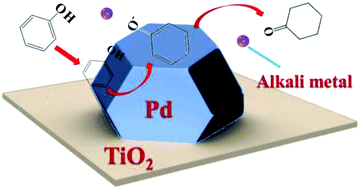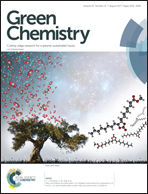Selective phenol hydrogenation to cyclohexanone over alkali–metal-promoted Pd/TiO2 in aqueous media†
Abstract
Selective phenol hydrogenation to cyclohexanone is an important process in both the chemical industry and renewable feedstock processing. However, the direct hydrogenation of phenol to cyclohexanone at mild conditions remains challenging. Here, we report an easily manufactured catalyst, alkali–metal-promoted Pd/TiO2, achieves 99% phenol conversion and 99% cyclohexanone selectivity at mild conditions of 80 °C and an extremely low H2 pressure of 0.06 MPa in water. By contrast, only about 18–36% phenol conversion is achieved using Pd/TiO2 that without addition of alkali metal at the same conditions. The kinetic studies and TOF values indicate that K or Na metals indeed promote the phenol conversion without changing cyclohexanone selectivity. Further studies suggest that the change of electronic structures over Pd NPs that induced by alkali metal is the main reason for enhanced phenol conversion. This result, combined with DFT calculations, suggest that phenol hydrogenation occurs both along the direct hydrogenation pathway and the dissociation and hydrogenation pathway over Pd/TiO2, and that the main pathway over alkali–metal-promoted Pd/TiO2 catalysts is the dissociation and hydrogenation pathway.



 Please wait while we load your content...
Please wait while we load your content...